This is a guest post by Heather Andrews, who recently interned at Adventure Cycling Association as part of her Master of Publishing program at Simon Fraser University. She regularly wordsmiths about bicycling and history, and provides opposable thumbs and faithful companionship to her 10 year old Australian shepherd Atticus. She blogs at Bikish. When Heather kindly offered to produce a profile of an interesting person at the nexus of the nerdy world of bicycling and publishing that she and I both inhabit, I jumped at the chance. The result was this profile of researcher and bicycle touring expert Heidi Beierle.
 Heidi Beierle (Photo courtesy of Greg Siple, Adventure Cycling Association)
Heidi Beierle (Photo courtesy of Greg Siple, Adventure Cycling Association)
Academic studies about the role of bicycling in cities often end up having substantial positive impact on policy and infrastructure. But this body of research has only begun to grow in recent years. When bicycling received any academic consideration at all before the 1990s, it was largely related to its role in social change or its potential as a solution to an energy crisis. By the 1990s, academics were starting to explore bicycling in city planning. Now, academics are just starting to expand their thinking outside of urban areas.
One researcher blazing the trail is Heidi Beierle of Eugene, OR. Beierle’s master’s thesis, “Bicycle Tourism as a Rural Economic Vehicle” (you can download a PDF here) has been gaining national attention as one of only a handful of academic studies about rural bicycling. I spoke with Beierle to learn more about her work.
Bicycles were a significant part of Beierle’s childhood in Cheyenne, WY. She continued riding as she moved around the country to pursue undergraduate and graduate studies. Eventually landing in Eugene, a “paradise for biking,” Heidi went car-free in 2007 and remains so today. While pursuing a graduate program in community and regional planning at University of Oregon, Heidi joked that she had spent the last several months sitting all day in classes, so she should spend the next several months riding her bike. She had only ever done one bike tour the previous summer, but what started as a joke slowly morphed into a solid plan. An invitation to the Preserving the Historic Road Conference in Washington DC and a supportive advisor cinched it: she would cross the country by bike while researching her thesis.
 Riding over McKenzie Pass (Photo courtesy of Heidi Beierle)
Riding over McKenzie Pass (Photo courtesy of Heidi Beierle)
Traveling along the TransAmerica Trail in Summer 2010 on a “creamy” orange Trek, Beierle distributed surveys to her fellow bike travelers. From this data she developed a document that presented four types of bicycle tourists, their travel patterns and spending habits. Beierle outlined the characteristics that made small towns attractive to bike tourists, which resulted in more dollars being spent there. Collecting this type of information for the first time, the document serves as a guide for citizens in rural communities to develop the bike-friendliness of their town and capture bicycle tourism dollars. Beierle’s research offers a small, but concrete solution to small towns across the United States looking for economic revitalization.
Beierle points out the small town of Guffey, CO, as a particularly interesting example of the relatively small steps communities can take to capture bike tourism dollars. Guffey is located just 1.5 miles off the TransAmerica Trail along a 60 mile stretch that lacks any other services. Citizens of Guffey managed to have an official sign placed on the nearby highway, encouraging cyclists to stop in. While visiting, a local citizen named Bill told Heidi, “we had to fight and fight to get that [sign]. Lots of people pass by here and then they end up in the middle of that without any services. It lets cyclists know that we’re here.” Heidi notes:
It only takes one person who cares a lot to make a small town bike-friendly. [They] wouldn’t fight to get a bicycle sign out on the highway with “Guffey” under it if they didn’t think a mutual beneficial synergy came from the cyclists in the
town.”
In the time since Beierle completed her thesis, she has attended the National Bike Summit (2011) and word of her work has started to spread around the bike tourism community. She caught the attention of the Adventure Cycling Association during her cross-country trip. Dedicated to bike travel, the national organization has included her work in their resources for building bike tourism and their advocacy for a United States Bicycle Route System. (You can also read about her work on their blog, and on bike touring blog The Path Less Pedaled).
Now that she has wrapped up her cross-country research project, Beierle is developing a business managing sustainable transportation projects. She hopes to continue her research on bike infrastructure in rural areas, and has already been working with Travel Oregon to establish new scenic bikeways in the state.
Beierle’s work offers solutions to real-world challenges and spotlights the opportunity for further research. For instance, her research could be built on by collecting financial data about the difference in spending habits between bicycle tourists versus automobile tourists.
Studies about urban bicycling are becoming well established, but academic exploration of bicycle touring is virtually non-existent. Projects like Beierle’s are paving the way for an emerging field of study.
This has been a guest post by Heather Andrews. Thanks, Heather! For more about cycle touring, check out today’s review on BikePortland of my friend Ellee Thalheimer’s new touring guide book that will give thousands more people the tools they need to participate in the economic impacts Beierle studies.
Like what you’re reading? Check out the zines.